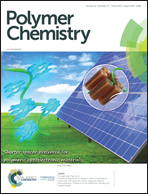Orthogonally clickable hyperbranched polymers: effect of reactant size and polarity on core-functionalization of peripherally jacketed HBPs†
Abstract
We describe a strategy for the preparation of an “orthogonally clickable” HB polyester (HBP) via a melt trans-esterification process, starting from a suitably designed AB2 monomer. The resulting HBP carries an allyl group on each repeat unit within the core-region and numerous propargyl groups on the molecular periphery; selective reaction of the periphery, to yield jacketed HBPs, permitted the examination of various factors that govern the access to internal reactive (allyl) sites. First, either hydrophobic docosyl (C22) or hydrophilic PEG350 segments were quantitatively clicked onto the periphery via the azide–yne reaction; subsequently, access of the internal allyl groups to thiol–ene reaction was examined using organic thiols of varying size and polarity. It was seen that the extent of reaction depends not only on the size of the thiol reactant but also on its relative polarity; for instance, a polar thiol is less effective in accessing the internal allyl groups of a HBP bearing docosyl segments on the periphery when compared to a non-polar thiol of roughly the same size. Likewise, when PEG segments are installed at the periphery, access to more polar reactants is favoured when compared to non-polar analogues of a similar size. These studies provide some interesting insights that could be useful in designing HBP supported catalysts for substrate-selective transformations.



 Please wait while we load your content...
Please wait while we load your content...